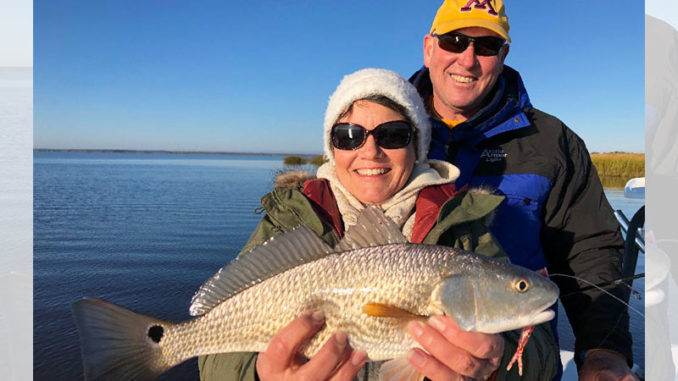
Redfish congregate in big schools this time of year
Fall in coastal estuaries means big catches of speckled trout, redfish, black drum and even a few doormat flounder. It’s the preferred time to fish for most, unless anglers are after golden, spot-tailed prey. Because winter redfish are the true pinnacle in coastal Carolina marshes. The pristine marshes around Georgetown, S.C., are prime places to attack big schools of reds in February.
Luckily, redfish feed year-round, and most anglers with a basic knowledge of inshore fishing can double up on redfish in many coastal areas. Reds are the pigs of the sea, known for eating just about anything from a lively swimming fish to chunks of dead bait rolling across the sea floor. But when many fish evacuate the estuaries in search of greener pastures, redfish do exactly the opposite. They pack up into large schools in the skinniest waters back in the heart of the tidal estuaries.
Georgetown is home to the massive area of marshes south of the Waccamaw Neck and the famed Winyah Bay area. This includes North Inlet, Santee Delta and Winyah Bay. The area is filled with thousands of acres of nursery habitat and top-tiered redfish wintering habitat, and Jordan Pate of Carolina Guide Service is geared up and ready for the winter smackdown.
Local guide loves chasing redfish in February
“February is one of my favorite times to fish for redfish, when they are well settled in their winter pattern,” said Pate (843-814-7900). “Redfish gang up in the shallows in big schools and are eager to eat.”
Pate, from Pawleys Island, fishes for reds from Murrells Inlet south to Bulls Bay. Winyah Bay is one of his favorite places to fish because of the fabulous fishing and the abundance of places he can go to find pooled up reds.
“Redfish remain in the same vicinity for weeks at a time and sometimes all winter long, but they can often move to the adjoining creek. I will often scout out new places and go up new creeks,” he said.
Pate fishes on both low and high tides; both offer anglers an advantage. Low tide will concentrate fish in tight places, but fish can be spooky when there isn’t much water available. On high water, fish have access to more ground but are more likely to eat.
Bait and lure choice is simple. Live bait on a light jighead is a dead ringer for a strong bite, but Pate will often use soft plastics and have high success.
“Matrix shad and Gulp on a light jighead are my go-to lures for these winter fish,” Pate said. “I like to cast them and work them very slowly along the bottom. The fish will often pick it up off the bottom even when dead sticked this time of year.”


